The beginning of the Russian-Japanese war. Part of 5. Attack on port arthur
25 January 1904 The Japanese Foreign Minister Baron Komura sent a telegram from Tokyo to St. Petersburg to the Japanese Ambassador Kurino, announcing the end of negotiations and “independent action” to defend his position, rights and interests. January 26 kurino (February 6) handed over two notes to the Russian Foreign Minister Lamsdorf. The first one said that Russia consistently rejected all of Japan’s proposals regarding Korea and Manchuria. This forces the Japanese government to “seriously consider self-defense measures.” The Russian side was informed that the negotiations were terminated, and Tokyo reserves for itself “the right to take such an independent action as it deems best to strengthen and protect its threatened position, ... to protect its established rights and legitimate interests.” The second note said that the Japanese government had exhausted all the reconciliation measures without result, and seeing that all “its fair views and moderate and disinterested proposals do not receive proper attention to them,” interrupts diplomatic relations with St. Petersburg. In response to these notes, which the Japanese envoy conveyed, Russian Emperor Nicholas II instructed Baron Rosen to leave Tokyo with the entire composition of his diplomatic mission.
Japanese notes clearly indicated that Japan decided to fight (a formal declaration of war was made on February 10 of 1904). Waiting for the official declaration of war in such conditions was stupid. Therefore, to talk about the sudden attack of Japan on Russia is not necessary. “Sudden” it became only for those Russian dignitaries and military who were in the illusions of the invincible power of the Russian Empire and the “insignificance and weakness” of the Japanese nation (like Emperor Nicholas, who called the Japanese “monkeys”).
The most competent Russian military correctly evaluated Japanese notes. So, January 26 (February 6) about the possibility of an unexpected Japanese attack fleet the head of the General Staff, Adjutant General Viktor Viktorovich Sakharov, told the location of the Russian fleet in order to paralyze the naval forces of the Russian Empire. In his opinion, the Russian fleet was to begin active operations and transfer them to the area of priority operations of the Japanese forces. On the same day, Vice Admiral S.O. Makarov wrote to the head of the Ministry of the Sea, F.K. Avelan, about the danger of the Russian fleet being located on the outer roads of Port Arthur. Staying ships on an external roadstead made it possible for the enemy to carry out a night attack. “The result of such an attack will be very difficult for us,” the Russian admiral emphasized. The Japanese fleet will not miss such an opportunity to strike us. “If we don’t put a fleet in the inner pool now, we will be forced to do it after the first night attack, paying dearly for the mistake.” Makarov once again acted as a seer. But they did not listen to his alarm in the Ministry of the Sea.
Thus, St. Petersburg had every opportunity to preempt the enemy, but did not. The result was sad. The Japanese armed forces were able to gain superiority at sea at the very beginning of the war, which gave them the opportunity to safely transfer ground forces. In the face of a shortage of Russian ground forces at the Manchurian Theater, Japan also gained an advantage on land.
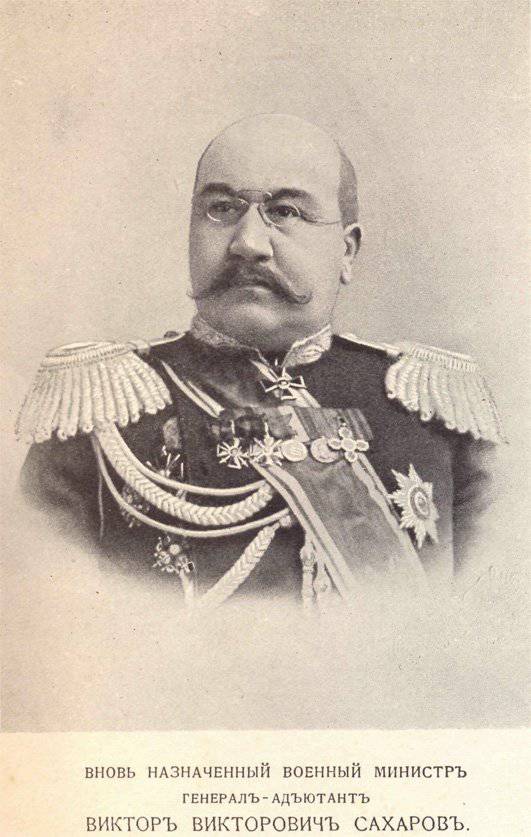
Attack on port arthur
Japanese intelligence vigilantly guarded every action of the Russian command, especially the sea, in the Far East. Therefore, the location of the Russian fleet on the outer roads did not go unnoticed. In Tokyo, the question of the war was decided, there was only the question of the bottom and hour of its beginning. At a meeting with the divine mikado (emperor), the Japanese high military command, headed by the Chief of the General Staff, Marshal Ivao Oyama and Vice Admiral Kheyhatiro Togo, decided on general mobilization, attack on the Russian fleet in its bases and on sending ground troops to Korea.
In fact, Japan started 24 January (4 February) 1904, when the Japanese ship in the Korean Strait, three miles from the coast and six miles from the port of Fusan, was captured by the civil ship of the Russian Voluntary Fleet "Yekaterinoslav". In Fuzane itself (Busan), the steamer of the Chinese East Road Mukden was seized and the landing of Japanese troops began. The same fate befell other Russian steamships, which by the will of fate turned out to be in those days in the Korea Strait - “Russia” and “Argun” and on the roads of the port city of Nagasaki - the steamer “Manchuria”. In addition, the Japanese captured Russian post offices in Fuzana and Mozampo.
Japanese attack on Port Arthur
Admiral Togo assembled the commanders of the ships of the United Fleet on the flagship battleship and gave them orders. Rear Admiral Uriu had with his detachment (with the addition of the cruiser "Assam") and 9-m and 14-m destroyer detachments to go to Chemulpo and attack the Russian ships there, and then guard the landing of troops. The rest of the forces were to go to Port Arthur. The destroyers were supposed to attack Russian ships in the raid at night. The squadron planned to join the battle the next day to complete the defeat of the Russian fleet. It should be noted that the Japanese command had a map of Port Arthur, a plan of the raid and harbor of Port Arthur, where the location of the Pacific squadron and the place of each ship were noted.
6 February 1904, the United Togo fleet departed from Sasebo base and headed north-west to the Yellow Sea. The fleet included 6 squadron battleships, 14 cruisers, and almost four dozen squadron destroyers and fighters. All along the way, the Japanese fleet did not meet any obstacles. February 7 Rear Admiral S. Uriu’s squadron (5 cruisers, 8 destroyers and 3 transports with troops) received an order to separate from the main forces and turn to the port of Chemulpo. In the afternoon of February 8, the main forces of the Togo fleet embarked at Round Island, 44 miles from the main naval base of the Russian squadron. In 6 hours of the evening, Togo gave the order to raise on the flagship a signal about the start of the first military operation.
On February 8, a British steamer came to Port Arthur with a Japanese consul from Chief. On this ship on the same day all the Japanese who lived in the city were taken to Japan. From them, Togo received the latest information about the Russian squadron.
On the night of February 9, the Pacific Squadron was on the outer roadstead of Port Arthur. The ships were located in positions of non-military, and peacetime. True, the crews in full force were on the ships, all the guns, except large-caliber, were charged. In the naval patrol sent two destroyers: "Quick" and "Fearless." On duty in case of anxiety, the duty cruisers of the squadron, the Askold and Diana, were also prepared. It is believed that if they were on guard, the Japanese attack could be thwarted or significantly weakened.
Contrary to the warnings of Makarov and other officers, the anti-torpedo networks were never dropped. In addition, from Retvizan and Pallas, the searchlights covered approaches to the external raid from the sea. This facilitated the attack of enemy mine fighters. On the flagship squadron battleship "Petropavlovsk" in 23 an hour ended the meeting with Vice Admiral O.V. Stark It discussed the possible activities in the event of an enemy attack. General sentiment was expressed by the Chief of the Naval Staff, Rear Admiral V.K. Witgeft. The chief of staff, saying goodbye to the commanders of the ships, said, “There will be no war.” These words were spoken half an hour before the start of the attack of the Japanese ships.
Battleship Retvisan in Port Arthur after a night attack
In addition, the success of the Japanese attack was facilitated by the fact that in Port Arthur only the governor Alekseev and people close to him knew about the severance of diplomatic relations between Russia and Japan. Neither the head of the fortress, nor the chief of artillery, nor the head of the headquarters of the fortress, nor the commander of the 7 of the East-Siberian rifle brigade reported this. As a result, in the midst of the battle, Stoessel was forced to request the headquarters of the fortress about the reasons for the shooting. And the headquarters of the fortress began to request the naval headquarters, and from there they reported that it was practical shooting. When, however, the alarm was announced, no one knew whether it was combat or training. And Vice-Admiral O. V. Stark did not believe for a long time that this was a real attack and even tried to stop the shooting. Only about an hour after the Japanese attack, he ordered the Novik and Askold cruisers to begin pursuing the enemy. It is clear that the Japanese destroyers have successfully disappeared.
Vice Admiral Togo divided his mine-bearing forces into two parts. Three detachments of destroyers (10 ships) went to Port Arthur, two detachments (8 of destroyers) to the port of Dalniy. The Japanese marched with the lights off and successfully passed the Russian patrol. The Japanese fighters, guided by the lighthouses and searchlights of the Russian ships, which illuminated the outer raid of Port Arthur, accurately reached the location of the Pacific squadron. On the outer roadstead of Port Arthur stood 16 pennants: 7 squadron battleships - "Petropavlovsk" (flagship), "Poltava", "Sevastopol", "Retvizan", "Victory", "Peresvet" and "Tsesarevich", 4 of the 1 cruiser rank - "Bayan", "Pallas", "Diana" and "Askold", 3 cruisers of the 2 rank - "Novik", "Boyarin" and "Djigit", gunboat "Zabiyaka", military transport "Angara". The squadron was located in four lines.
Japanese destroyers attacked in 23.30. The battle lasted more than an hour. The first torpedo in 23.33 was released by the destroyer "Sirakumo", which was the commander of the 1-th detachment of the destroyers, captain 1-rank Asai Seijiro. The watch officer of the squadron battleship "Retvizan" Razvozov, finding two destroyers, immediately gave the order to open fire. But at that moment a torpedo hit the battleship. She struck in the bow of the left side. Killed five sailors. The ship began to roll on the port side, the lights went out. To level the battleship, flooded the cellar of the starboard. Heel a few straightened. Hole closed with a plaster, electric lighting restored. At the same time the ship was firing indiscriminately. Over night, the ship fired 150 shells. The commander of the ship, fearing flooding, with the permission of the commander, led the ship to the passage to the internal raid. There was no high water (high tide), so Retvizan ran aground, blocking half the aisle. Three compartments of the battleship were flooded, the ship received 2,2 thousand tons of water.
The second torpedo, in the stern part of the left side, was received by the squadron battleship "Tsarevich". The ship had a rudder damaged, the stern compartments were flooded, the list reached 18 degrees. Battleship also moved into the inner harbor. Along the way, he was attacked twice more, but the torpedoes passed by. The third Japanese torpedo hit the cruiser Pallas. The torpedo hit the middle of the hull. As a result, there was a strong fire in the coal pit. One sailor died, four more were fatally wounded. More 38 people were injured or poisoned.
Japanese ships were attacking single torpedoes from a distance in the 1-2 cable, that is, almost at close range. The attack conditions were almost perfect. In total, during the night attack, Japanese fighters fired 16 torpedoes. The results of the attack were not as successful as the Japanese command had done. Only 3 torpedoes hit the target. Part of the torpedoes did not explode. As it turned out later, the Japanese sailors hurried and fired torpedoes with an unstuck check (in the failed state).
The Japanese attack could have been more successful if Togo had not separated the destructive forces. Apparently, Togo still did not have complete information about the location of the Russian squadron and in vain sent a significant part of the destroyers to the port of Dalniy. If the Japanese destroyers attacked the outer raid of Port Arthur in full force, the operation could become more successful.
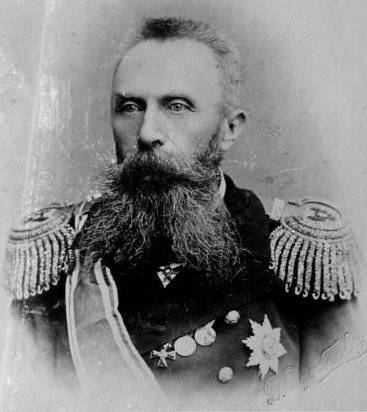
Admiral Oskar Viktorovich Stark
In general, the Japanese attack should be considered successful. For a considerable time, two of the most powerful ships of the Pacific squadron, Retvizan and Tsesarevich, were put out of action. They were then repaired within six months. This gave an advantage to the Japanese fleet. In addition, in Port Arthur there were no docks that could accommodate such ships. This seriously complicated the repair of armadillos.
Japanese destroyers, having received minor damage, went to the open sea. To repel a possible re-attack, cruisers and destroyers of the sea came out. They created a patrol chain.
Unfortunately, even the first battle did not lead Petersburg out of a relaxed state, did not force the top leadership of the empire to mobilize itself and a great power to the war. So, when the leader of the Bessarabian nobility, Krupensky asked the emperor what would happen after Japan’s first success, Nicholas said that he looked at all this as a “flea bite”.
Map source: P. D. Bykov. Russian-Japanese War 1904-1905 Actions at sea
Morning fight
Togo did not know the results of the night battle. Therefore, in the morning he sent a cruiser detachment for reconnaissance. 09: 00 Japanese cruisers came close enough to evaluate the results of the night attack. Vice Admiral Devu Sigato overestimated the results of the attack. It seemed to him that the large ship 3-4 was badly damaged, and the smaller ships were in obvious disarray. This he reported to Togo. The Japanese command decided that the moment for attack was a good one. Although originally Togo hoped to lure the Russian ships from the raid, where they were supported by the coastal battery. The Japanese admiral decided to take a chance. Togo attached great importance to this attack and raised a “victory or defeat” signal on the flagship. Everyone should have tried their best.
Russian ships were still on the outer raid. Two damaged battleships and a cruiser were stranded near the shore. The squadron commander Admiral Stark was on the report of Alekseev. Moreover, the command did not organize a patrol service; there was not a single destroyer in the sea. On the peaks that surrounded Port Arthur, no observation posts were set up.
It became known about the attack only when in 11.07 the enemy opened fire on the Russian squadron from a long distance (8,5 km). Our command then did not even conduct firing at such long distances. Russian ships fired back and began to be removed from the anchors to meet the enemy. But then the governor Alekseev ordered to wait for Admiral Stark. The ships lost a few precious minutes. Only in 11.14 ships under enemy fire were removed from the anchor. This delay led to the damage of several ships and could have led to the defeat of the Russian squadron if the Japanese had shot better.
Initially, the Russian squadron was built into the wake of the wake and led the rapprochement with the enemy, firing from the nose guns. Then the Pacific squadron, in 11.23, fell on the backcourse with the Japanese fleet and fired at the enemy with a starboard. Japanese ships came under fire from coastal batteries, but they opened fire with a delay - in 11.30. Precious time has been lost.
It was then that Togo realized that his calculations for the success of the night attack were greatly overvalued. The threat of a decisive defeat of the Japanese fleet from the Russian squadron, which had the support of coastal batteries, appeared. In 11.45, the Japanese admiral squadron order to turn south. A few minutes later the Japanese ships left the zone of shelling of the Russian ships and coastal batteries.
The Russian command in this battle made almost all the mistakes that could be made. The patrol service missed the appearance of the enemy. Admiral Stark missed the exceptional opportunity to inflict heavy casualties on the enemy fleet, which was lined up in the same wake or even destroyed. Played a negative role and poor artillery skills. If the Russian gunners on the ships and coastal batteries in the pre-war period were well trained, the Japanese squadron would have been destroyed.
Both sides shot badly. Thus, during the battle, the Russian squadron fired 2207 shells at the enemy, and the coastal guns fired 151 shells, and the total number of hits was 11. 14 people were killed on Russian ships, 71 was wounded. Russian ships got 29 hits of Japanese shells. The Japanese fleet, according to Japanese data, lost 3 people killed, 69 wounded.
As a result, the battle did not bring success to one of the parties. Neither the Japanese nor the Russians sank a single ship, several ships were damaged. Togo overestimated the results of the night attack and led a decisive attack on the Russian fleet, hoping to destroy it completely. However, much mistaken. The Japanese fleet was saved only by the sluggishness of the Russian command. The Russian fleet and coastal batteries did not use a unique opportunity to inflict heavy damage on the enemy. In general, after the battle, the Japanese were in a more advantageous position, since they had better developed shipbuilding and repair facilities. So, in Sasebo there was a dry dock, and the repair capabilities of Port Arthur were limited.
The death of "Varyag" and further hostilities
February 8 Uriu landed amphibious forces at Chemulpo and invited Russian ships to leave the harbor. February 9 cruiser "Variag" and gunboat "Koreyets" took the fight and died. In many ways, the death of these ships is on the conscience of the governor Alexeyev. He was aware of the threat of a Japanese attack, but did not recall these ships at Port Arthur. As a result, they were put in a disastrous position.
Admiral Togo, who held on a temporary base near Chemulpo, decided to block the Russian squadron. Mining approaches, flooding of old ships and bombardment from the sea were to lead to the defeat of the Russian fleet. The Russian command refused to take action and on February 10 all ships were transferred to the inner harbor. The fleets were limited to reconnaissance in the near zone and support for the defense of the Kwantung Peninsula.
February 12 Russian fleet lost two more ships. At the closest approaches to Port Arthur began to put minefields. The Yenisei transport mines hit a mine of its own. On the shore, they considered that he was attacked by the enemy, and they sent to help the armored cruiser Boyar. The cruiser was on the actual minefield and also hit. Captain V. F. Sarychev decided to leave the ship, which seemed to perish. However, the ship was already killed by the second explosion, when it was demolished on new mines.
Togo decided to block the Russian fleet by flooding several ships in a narrow exit from the inner harbor. February 20 Japanese fleet moved to Port Arthur. On the night of February 23, several enemy firewalls, with the support of the destroyers, attempted to implement this plan. However, the Russian patrol ships, with the support of Retvizan, repulsed this attack. One brander was sunk, another was badly damaged and thrown onto coastal stones. February 24 squadron of Togo approached Port Arthur, exchanged shots with Russian cruisers who left the harbor and returned to Chemulpo. At Port Arthur, the Japanese cruiser detachment was abandoned. February 25 Japanese cruisers tried to cut off from the Port Arthur two Russian patrol destroyers - "Fearless" and "Impressive." "Fearless" was able to get through to the base. “Impressive was forced to hide in Pigeon Bay. To prevent the ship from getting to the enemy, Lieutenant MS Podushkin flooded him.
Battleships Tsesarevich and Retvizan in the internal pool of Port Arthur.
Thus, at the beginning of the war, the most favorable situation developed for the Japanese Empire. The Russian fleet, which posed a great threat to the plans of the Japanese command, was inactive. Admiral Stark, despite the continued combat capability of the Pacific Squadron and the ability to fight for supremacy in the Yellow Sea, refused to take action. In the Korean ports of Tsinampo and Chemulpo, the Japanese began the landing of expeditionary forces. There, the first echelon of General Japanese Kuroki's 1 of the Japanese Army landed. The traffic flow from the Japanese ports went almost continuously. From the ships, Japanese troops were transferred to boats, sampans, boats and junks, and landed on the shore.
February 9 mobilization was announced in the troops of the Far East and Siberia. Martial law declared in Port Arthur and Vladivostok. February 14 Japanese have already occupied Seoul. Here the Japanese first encountered the Cossacks. Cossack hundred knocked over the Japanese cavalry squadron and drove him to Seoul. The Russian commander did not continue to pursue the enemy. He had to watch the enemy. Soon all of Korea was lost.
As a result, neither Alekseev, nor Kuropatkin, nor Stark, as the military leaders of the Russian armed forces in the Far East, could solve the main task of the initial stage of the war - to disrupt the landing of Japanese troops in Korea. The war on land was practically not fought. The Japanese calmly disembarked the troops, weapons and materiel. The troops were pulled up to the border river Yalu, to the border of South Manchuria. At the same time, the Japanese command was mistaken with the timing of the transfer of troops. The transfer of troops from Japan to Korea took place at a slower pace than originally planned. The Japanese combined fleet was engaged in the blockade of Port Arthur and the covering of the landing craft. Some of his forces were distracted by the Vladivostok squad of cruisers.
The cruiser "Boyar" in the Far East, 1903 year.
Sources:
P. P. Bykov. Russian-Japanese War 1904-1905 Actions on the sea // http://militera.lib.ru/h/bykov_pd/index.html.
Kremlin S. Russia and Japan. Bleed! M., 2005.
Kuropatkin A.N. The Russian-Japanese War, 1904-1905: Results of the War. SPb., 2002 // http://militera.lib.ru/h/kuropatkin/index.html.
Levitsky N. А. The Russian-Japanese War 1904-1905 M., 2003 // http://militera.lib.ru/h/levicky_na/index.html.
Martin Christopher. Russian-Japanese war. 1904-1905. M., 2003.
Molodyakov V. Russia and Japan. The rails are buzzing. M., 2006.
Russian-Japanese war. From Vladivostok to Tsushima. M., 2004.
Utkin A. Russian-Japanese War. At the beginning of all troubles. M., 2005.
Shirokorad A. Japan. Unfinished rivalry. M., 2008.
Shishov A.V. Russia and Japan. History military conflicts. M., 2001 // http://militera.lib.ru/h/shihsov_av/index.html.
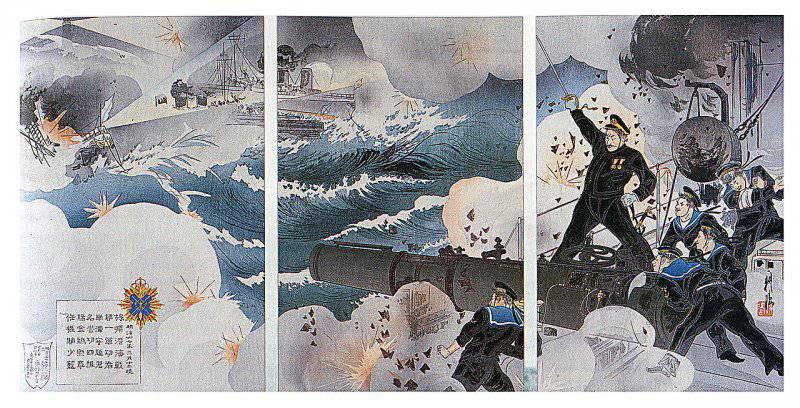
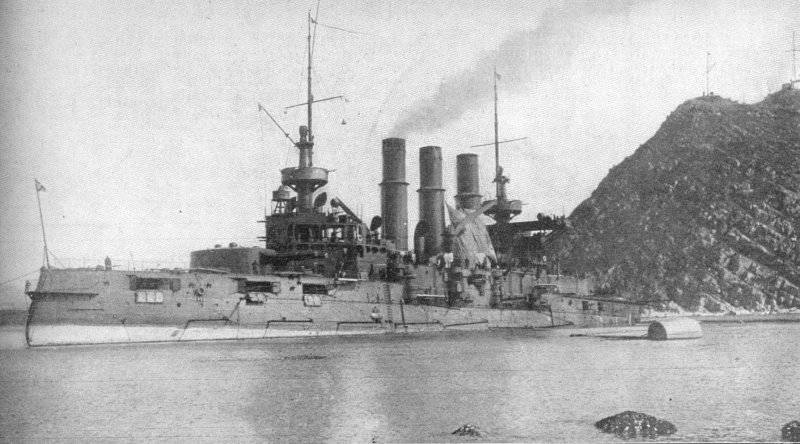
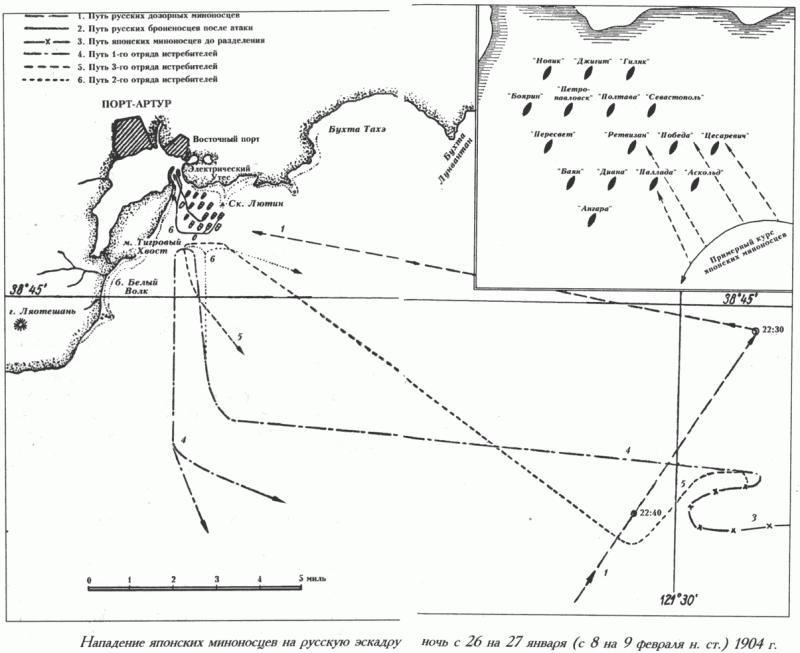
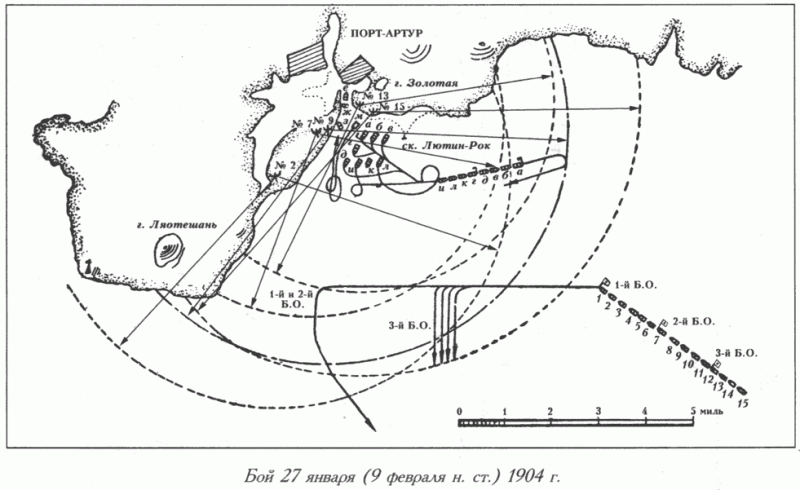
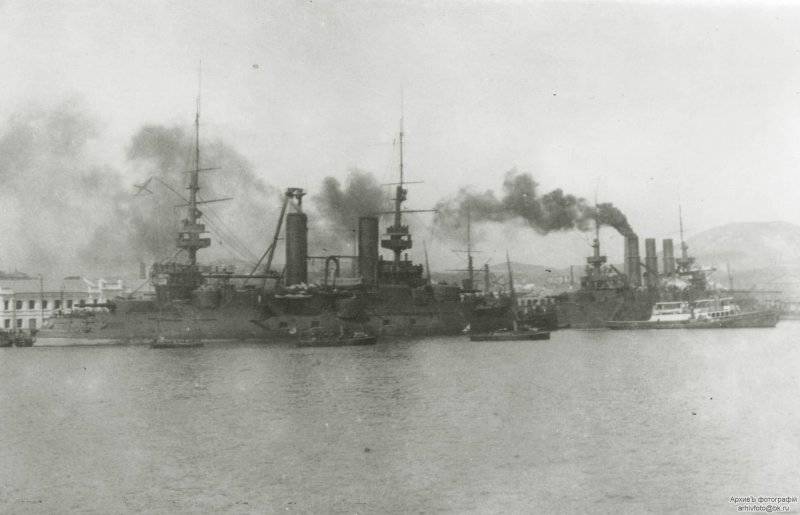
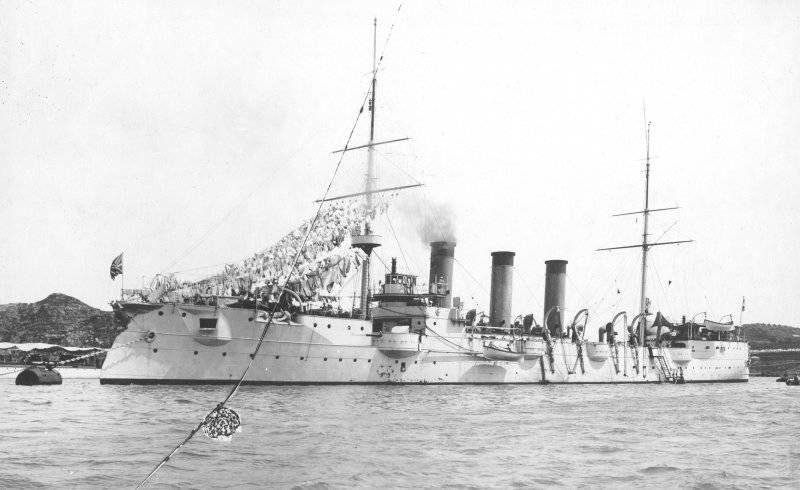
Information